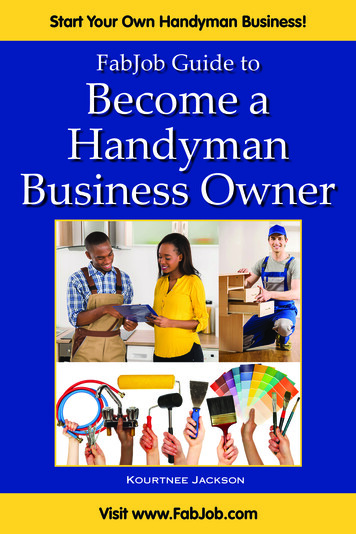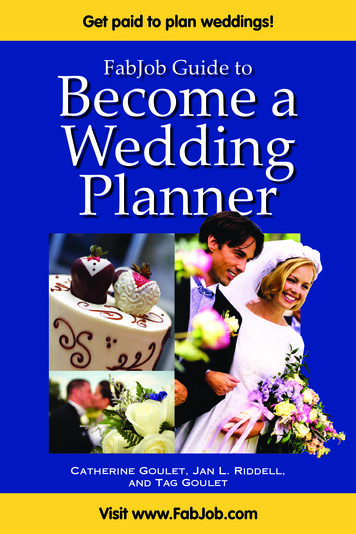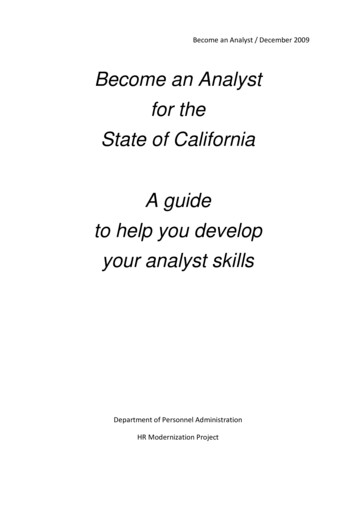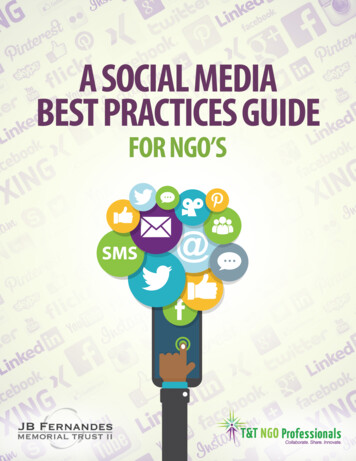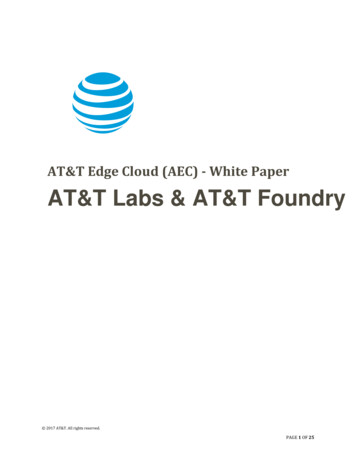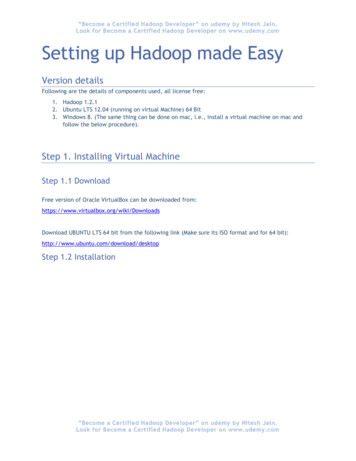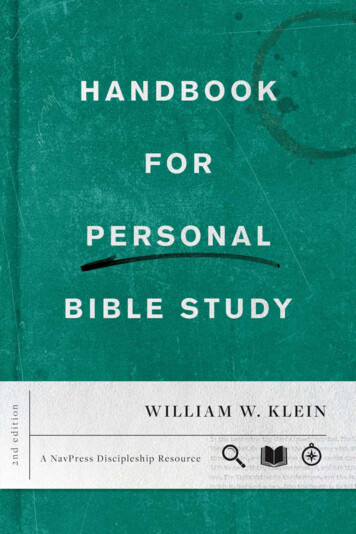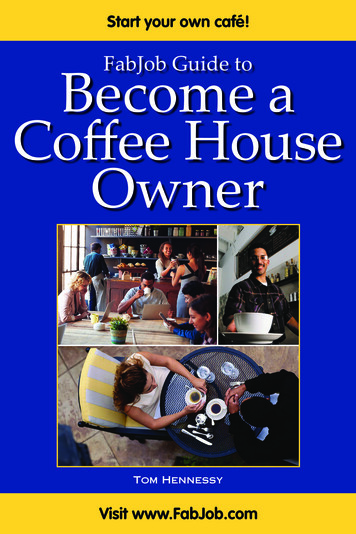
Transcription
Start your own café!FabJob Guide toBecome aCoffee HouseOwnerTom HennessyVisit www.FabJob.com
FabJob Guide to Become a Coffee House OwnerContentsAbout the Author.101. Introduction.111.1 Owning A Coffee House.111.2 What a Coffee House Owner Does.131.2.1 Coffee House Lingo.131.2.2 Coffee Basics.191.3 Inside This Guide.202. Getting Ready.222.1 Skills and Knowledge You Will Need.222.1.1 Self-Evaluation Quiz.222.1.2 Interpersonal Skills.242.1.3 Business Skills.262.1.4 Work in a Coffee House.292.1.5 Getting Related Food Service Experience.302.1.6 Be Your Own “Mystery Shopper”.322.2 Learn From Other Business Owners.362.2.1 Talk to Coffee House Owners.362.2.2 Join an Association.382.3 Educational Programs .412.3.1 Business Courses.422.3.2 Barista Courses.432.4 Resources for Self-Study.452.4.1 Books.452.4.2 Websites.462.4.3 Coffee and Gourmet Food Shows.462.4.4 Magazines.472 fabjob.com Copyright 2017 FabJob Inc.
FabJob Guide to Become a Coffee House Owner3.Starting Your Own Coffee House.493.13.2Options for Starting a Coffee House .503.1.1Buying an Established Shop.503.1.2Franchising.573.1.3Opening a New Coffee House.62Getting Started.623.2.1Creating a Business Plan.633.2.2Forming a Company.763.2.3Hiring a Lawyer and an Accountant.833.2.4Funding Sources.843.3 Taxes, Insurance, and Licenses.923.3.1Taxes.923.3.2Insurance .953.3.3Licenses.983.3.4Naming Your Coffee House.1004. Choosing Your Location, Equipment, and Suppliers.1024.14.24.3Choosing the Right Location.1024.1.1Points to Consider.1044.1.2Keeping Track of Places You’ve Seen.1084.1.3Signing Your Lease.112Building Your Coffee House.1214.2.1Coffee House Design.1224.2.2Layout Specifics.1244.2.3Choosing a Contractor.1294.2.4Codes and Inspections.132Equipment and Supplies.1334.3.1Buying Equipment.1334.3.2Equipment Checklist.141Copyright 2017 FabJob Inc. fabjob.com 3
FabJob Guide to Become a Coffee House Owner4.4Food Distributors.1445. Setting Up Your Coffee House.1485.1 Beverages.1485.25.35.45.1.1Roasting Your Own Beans.1485.1.2Brewing Coffee.1555.1.3Espresso Basics.1565.1.4Specialty Coffee Drinks.1595.1.5Other Specialty Drinks.162Food.1645.2.1Menu Planning.1645.2.2Sandwich and Soup Basics.169The Oyster: Creating an ing.180Preparing for Customers.1815.5 Opening Your Coffee House.1836.Managing Your Coffee House.1886.1The Business System.1886.2Hiring Your Staff.1906.346.2.1Getting Ready to Hire Help.1906.2.2The Hiring Process.1966.2.3New Employee Paperwork.201Training Employees.2056.3.1Employee Training Ideas.2056.3.2Solutions to Training Glitches.208 fabjob.com Copyright 2017 FabJob Inc.
FabJob Guide to Become a Coffee House Owner6.3.36.46.56.66.77.Red and Blue Employees.208Employee Checklists.2096.4.1Where to Start.2106.4.2Daily Duties.2116.4.3Weekly Duties.2126.4.4Manager Checklist.216Maintenance and Repairs.2186.5.1The General Maintenance (GM) Book.2186.5.2The Repair and Maintenance (R&M) Book .219Bookkeeping System.2216.6.1Create a Daily Sales Report.2226.6.2How to Use a DSR.2236.6.3Correcting Errors.2246.6.4Accepting Payment.2256.6.5Keeping Track of Your Finances.229The Manager Meeting.2336.7.1Tips for Running a Meeting.2336.7.2Items to Cover in the Manager Meeting.234Getting and Keeping Customers.2367.1 Marketing Tools .2377.1.1 Printed Materials.2377.1.2 Your Website.2437.1.3 Social Media .2487.2 Marketing Techniques .2527.2.1 Advertising .2527.2.2 Free Media Publicity.2577.2.3 In-Store Promotions.262Copyright 2017 FabJob Inc. fabjob.com 5
FabJob Guide to Become a Coffee House Owner7.3 Customer Service and Feedback.2667.3.1 Talk to Your Customers.2667.3.2 Comment Cards.2677.3.3 Frequent Customer Cards.2698.Budgets and Building Wealth.2718.18.28.38.48.58.66Why a Budget is Essential.2718.1.1Profit and Loss (P&L) Statement.2728.1.2Managing Sales.2738.1.3Cost of Sales and Inventory.274Labor Costs.2808.2.1Labor Cost by Percentage.2808.2.2Labor Formula by Actual Cost.2818.2.3Labor Saving Tips.281Other Expenses.2828.3.1Controllable Expenses.2828.3.2Noncontrollable Expenses.285Tracking Sales.2878.4.1Sales Pace.2878.4.2Cost of Sales.2888.4.3Labor.2888.4.4Your Scoreboard.289Audits.2918.5.1The Internal Audit.2918.5.2Scoring The Audit.2928.5.3The External Audit.294The Bonus System.2968.6.1Bonus Calculations.2978.6.2How the Audit Affects Bonuses.298 fabjob.com Copyright 2017 FabJob Inc.
FabJob Guide to Become a Coffee House Owner8.79.Building Wealth.2988.7.1Compound Interest and Debt.2998.7.2Paying Off Debt.300Conclusion.304This edition of the guide is from 2017. You can find the most recentlyupdated information for this career in the Coffee House OwnerCertificate Course offered by International Association of ProfessionsCareer College (also known as IAP Career College) at iapcollege.com.Visit Coffee House Owner Certificate Course to learn more.Copyright 2017 FabJob Inc. fabjob.com 7
FabJob Guide to Become a Coffee House Owner1. Introduction1.1 Owning A Coffee HouseIn 1984, I was living in Santa Fe, New Mexico, managing a restaurantclose to the downtown plaza. I was fortunate enough to live withinwalking distance of work. This was a real treat, because Santa Fe is anideal location for walking. There is so much to see: beautiful Puebloarchitecture connected by a street layout that was made for donkeysinstead of automobiles. It truly is not like most state capitals.One of my favorite stops on my way to work was a small coffee houseon the corner of two well-traveled paths. It was a tiny place, with anespresso machine sitting on a counter and a few pastries displayedbehind the glass case. One wall was full of magazines — maybe 75 titles.In between the counter and the magazines was a jumble of marble-toptables for customers to sit at. There was also a spiral staircase leading toa small loft of about 200 square feet. The loft had comfortable seating,and usually this area was filled with students reading or playing cardsor chess. The aroma of coffee perfumed the air; it felt very European tobe there, something of a throwback to bohemian Paris. You could seethat the customers were truly enjoying the atmosphere.8 fabjob.com Copyright 2017 FabJob Inc.
FabJob Guide to Become a Coffee House OwnerA Coffee House is the Ideal BusinessCompared to my restaurant job, this seemed like the ideal business tooperate. The idea of a coffee house appeared to be so simple. In myrestaurant, I had a staff of about 75; at the coffee house, there werenever more than two people working at a time. While my restauranthad a large menu that took hours to prepare, this place had only a fewsimple items made by a local bakery. I was hooked! My goal was to runa coffee house of my own.Five years later, I opened my own café in Santa Fe. My businesspartners were also my best friends. We had already opened three otherfull-service restaurants, but the café was easier — and a lot more fun.It wasn’t even that hard to do. I don’t know why I waited so long.What could be better after an early Sunday morning bike ride thanstopping at the local coffee house to meet friends? Who isn’t comfortedat the idea of a fresh muffin and a steaming cup of aromatic, dark,robust coffee? After going through the process myself, I can tell youthat there is only one thing better than going to your local coffee house:owning the local coffee house yourself.The Origin of Coffee HousesWhen you own a coffee house, you become part of a rich culture thatdates back to the time of King Solomon. In fact, the first public coffeehouses recorded in history date back to 15th century Turkey and theidea quickly spread throughout Europe during the next century. Sincethat time, the coffee house has come to symbolize a more cultured sideof humanity. Historically, it has provided a place for people to gatherto discuss politics, music, poetry, romance, or even rebellion. In today’scoffee culture, drinking coffee is seen as being social, affluent, anddownright hip.Understanding the Perfect Cup of CoffeeOne of the most important requirements of owning a coffee house isloving coffee. That means not only enjoying the flavor or aroma of thedrink but also loving the coffee culture as well. I’m not saying coffee hasto become a religion, but it’s crucial to have an appreciation of the coffeeroaster’s craft.Copyright 2017 FabJob Inc. fabjob.com 9
FabJob Guide to Become a Coffee House OwnerFamiliarize yourself with the roasting process. Get to know thecharacter of the bean and how to ensure the perfect roast. Understandall the nuances of grinding and brewing a perfect cup of coffee. Andfinally, teach your staff how to do all of these things consistently too.1.2 What a Coffee House Owner DoesA coffee house owner should be fully educated in all the nuances ofcoffee, from coffee house lingo to production to brewing to serving.Therefore, let’s go over some of these basics before we get into the nutsand bolts of the coffee house business.1.2.1 Coffee House LingoAll businesses develop their own language, but I don’t think any isas colorful as the coffee business. Remember that scene in the movieL.A. Story where a group of friends are sitting around a table in a trendyrestaurant, and the waiter asks if anyone would like to have coffee aftertheir meal? That begins a round of ordering every type of coffee drinkimaginable — a very funny scene when “coffee house hip” culture wasonly thriving in a few places in North America.What was hip then is the norm now. So to get familiar with the manyways your customers may be ordering coffee from you, it is best to goover the different types of coffee names, as well as other business lingothat is used in restaurants and coffee houses. It is a language all byitself, one that can be fun to learn.86To get rid of, as in “86 the cinnamon.”AffogatoA coffee-based beverage or dessert. “Affogato”(Italian for “drowned”) refers to topping a drink ordessert with espresso and may also include caramelsauce or chocolate sauce.AmericanoEspresso with hot water added to dilute it. Similarto drip coffee, except it is made to order with yourespresso machine.BaristaThe person who operates the espresso machine,much like a bartender.10 fabjob.com Copyright 2017 FabJob Inc.
FabJob Guide to Become a Coffee House OwnerBlack EyeA dripped coffee with a double shot of espresso.Black TieA traditional Thai iced tea with a mix of chilledblack tea, orange blossom water, star anise, crushedtamarind, sugar and condensed milk or cream. Tothis, add a double shot of espresso. With only oneshot of espresso, it’s a Red Tie.BreveEspresso with steamed half-and-half.Café Au LaitDrip coffee with hot or boiled milk poured into a cupat the same time.Café BombónThis uses espresso served with condensed milk ina 1:1 ratio. Served in a glass, the condensed milkis slowly added to sink underneath the coffee andcreate contrasting bands.Café Con LecheEspresso with enough steamed milk to fill a regularsized cup.Café Con PannaA demitasse (small cup) of espresso with a dollop ofwhipped cream.Café CorrettoEspresso with cognac or some other spirit added.Café CrèmeA shot of espresso with an ounce of heavy cream.Café FreddoEspresso served in a chilled glass, mostly over ice.Café LatteThe most popular coffee drink. A shot of espressowith steamed milk, topped with foamed milk.Café MacchiatoA shot of espresso with a teaspoon or two of foamedmilk. “Macchiato” means marked, so you aremarking the espresso with a touch of foamed milk.Café MediciA double espresso with chocolate and a touch ofwhipped cream. Usually, this is made with chocolatesyrup, but occasionally a barista may use a smallchunk of real chocolate in the bottom of the cup, thenbrew the espresso on top. It will melt some of thechocolate – but not all of it – leaving a nice chocolatetreat at the bottom.Copyright 2017 FabJob Inc. fabjob.com 11
FabJob Guide to Become a Coffee House OwnerCafé MélangeA black coffee mixed or covered with whippedcream, popular in western Europe.Café MielWith a shot of espresso, steamed milk, cinnamon,and honey. The name is from the Spanish word forhoney, miel.Café MochaA café latte with chocolate added. It can just have thefoamed milk on top, or have whipped cream withchocolate sprinkled as a finish.Café RistrettoA short shot of espresso, using the same amountof coffee as a regular shot. This just means thatyou don’t run the espresso machine as long, sothere is less liquid. The result is a stronger, moreconcentrated coffee.Café sua daIn Vietnamese, meaning “iced milk coffee,” it’sblack coffee mixed with a quarter to a half as muchsweetened condensed milk and then poured overice.Café ZorroThis is double espresso added to hot water with a 1:1ratio.Cake in a CupA double shot of espresso with double cream anddouble sugar.CappuccinoA shot of espresso with foamed milk spooned on top.Similar to the café latte, the cappuccino has morefoam on top, acting as an insulator to help retain theheat of the beverage. Cappuccino contains one-thirdespresso, one-third steamed milk, and one-thirdfoam.Chai LatteInstead of espresso, a normal café latte is flavoredwith a spiced tea concentrate. When you add a shotof espresso, it’s a Dirty Chai Latte.CremaThe caramel-colored foam that comes to the surfaceof the espresso — much like the head on a beer,only slightly thinner. The crema is vital to a goodespresso. It is made up of the solubles that passthrough during the brewing process.12 fabjob.com Copyright 2017 FabJob Inc.
FabJob Guide to Become a Coffee House OwnerDemitasseA small espresso cup. It should be only large enoughfor a single espresso. This attractive cup is for thestraight espresso with nothing else added.DoppioThis is just the Italian way to order a double. Itsounds better than saying “double.”DripRegular coffee.DryWith just foam and no steamed milk.EiskaffeeThis literally means “ice cream coffee” in German.It is a popular German drink consisting of chilledcoffee, milk, sweetener, vanilla ice cream, andsometimes whipped cream.EspressoThe coffee brewed from an espresso machine. Hotwater is pressed through the coffee by way of a pumpor a piston, as compared to a drip machine, whichuses gravity.Espresso RomanoA shot of espresso with a small rind of lemon andsugar added to it.Flat WhiteAn espresso made like a latte or a cappuccino, but themilk is not foamed.FrappuccinoA Starbucks creation. Basically a chilled cappuccinothat is sweetened and has other flavor ingredients.The recipe is owned by Starbucks.GalãoA hot drink from Portugal made of espresso andfoamed milk; use one-quarter coffee to threequarters foamed milk.GrandeA 16-ounce cup.GranitaA latte with frozen milk.GuillermoOne or two shots of hot espresso poured over slicesof lime. It can also be served over ice with sometimesa little bit of milk.Half-CaffAny coffee drink made half with caffeinated coffeeand half with decaf.Copyright 2017 FabJob Inc. fabjob.com 13
FabJob Guide to Become a Coffee House OwnerHarmlessA cool way to say you want your drink as a decaf.Irish CoffeeCoffee combined with whiskey and cream. Sugarmay be added if desired.Kopi SusuSimilar to the Café (or Ca phe) sua da and means“milk coffee.” Mix black coffee with about a quarterto half a glass of sweetened condensed milk thenlet stand to cool, allowing the grounds to sink tothe bottom. (Don’t drink this to the end unless youintend to “eat” the grounds.)Liqueur CoffeeCoffee brewed with a 25ml shot of liqueur. Add theliqueur of choice first with a teaspoon of raw canesugar mixed in. Next fill to within an inch of thetop with good, strong, fresh filter coffee. Pour fresh,chilled, slightly whipped cream carefully over theback of a cold teaspoon so that it floats on top of thecoffee and liqueur mixture.MazagranIn Portugal this long cold coffee beverage is madewith at least strong coffee (usually espresso), lemonand ice. Sometimes sugar, rum or water is added.Served in a tall glass.MochaccinoLike a café mocha except on a cappuccino instead ofa latte.NicoA breve with orange syrup and cinnamon.On a LeashOrdered to go with handles (referring to the cup).PocilloA shot or small portion of unsweetened coffeeusually made using an espresso machine or acaffettiera, but traditionally made using a cloth drip.QuadFour shots, or a “double double.”Red EyeDrip coffee with a single shot of espresso added.Rice Dream LatteA latte made with rice dream — a non-dairy milkreplacement.ShortAn 8-ounce cup.14 fabjob.com Copyright 2017 FabJob Inc.
FabJob Guide to Become a Coffee House OwnerShotA single dose of espresso.Shot in the DarkDrip coffee with a single shot of espresso in it.SingleSame as a shot.SkinnyA latte or cappuccino made with nonfat milk insteadof regular milk.Skinny HarmlessNonfat, decaf. But I like the other name for it: “WhyBother?”Soy LatteA latte made with soy milk instead of regular milk.TallA 12-ounce cup.TripleThree shots.Turkish CoffeeBeans for Turkish coffee are ground or poundedto the finest possible powder, finer than any otherway of preparation. The coffee grounds are thenimmersed in (hot but not boiling) water long enoughto dissolve the flavorsome compounds.Two-TopA table for two. (You’ll also encounter “three-top,”“four-top,” etc.)UnleadedAnother good way of saying “decaf.”VentiA 20-ounce cup.Vienna CoffeeTwo espresso shots in a standard sized coffee cupplus whipped cream to fill the cup.WetAdd steamed milk with no foam.WhiplessNo whipped cream.White ChocolateMochaEspresso, steamed milk and white chocolate syrup.A mix of regular Cafe Mocha and White ChocolateMocha is called a Zebra MochaWith LegsA cup with handles.With RoomLeaving space at the top so the customer can addcream.Copyright 2017 FabJob Inc. fabjob.com 15
FabJob Guide to Become a Coffee House OwnerYou may decide to use all of these terms or just some of them, or youmay learn new ones. In any case, they can be a lot of fun if you let yourcustomers in on the lingo. Try printing a list of terms and putting themon a table-tent (a printed card that is placed on the tables). This way,your customers can learn the lingo while sipping their “tall skinny halfcaff.”1.2.2 Coffee BasicsCoffee comes from bean-shaped seeds found inside the cherrylike fruitsof coffee trees and shrubs. While the coffee plant originated in Africa,it eventually found its way to other continents as well. There are manytypes of coffee plants, but we only need to concentrate on two types:Arabica and Robusta.Robusta coffee is grown at lower elevations and is used in cheaperblends and instant coffees. When you buy coffee in a can, it is usuallyRobusta. It has more caffeine than its Arabica cousin. The beans havea more rounded shape to them, which makes them easy to recognize.Arabica coffee is grown at higher elevations and has more of an ovalshaped bean. These beans are of a higher quality and represent themajority of the beans grown in the world. As the owner of a qualitycoffee house, you will be buying this type of bean.ProcessingA single coffee tree will produce approximately one pound ofcoffee — around 2,000 beans. Each cherry is handpicked and then fedinto a machine to separate the cherry meat from the seeds, or beans.The beans are held long enough to ferment, which breaks down theircoating and raises their acidity.Afterwards, the beans are dried, either in the sun on concrete slabs or indrum-style dryers. When the beans have dried sufficiently, a protectivehusk needs to be removed. This is accomplished by milling the beans,which gently crushes them, removing this protective skin. Finally, thebeans are sorted, graded, and allowed to dry before shipping to theroaster.16 fabjob.com Copyright 2017 FabJob Inc.
FabJob Guide to Become a Coffee House OwnerRoastingOnce the person doing the roasting receives the beans, he or she willdetermine the type of roast that is best for that particular variety. Whilethere are general guidelines, much depends on the roaster’s preferencesand tastes.The actual roasting machine is a rotating drum with a heat sourceunderneath it. Once the desired temperature is reached inside themachine, the beans are added and the drum constantly turns until thetarget roast is achieved. This process is timed down to the exact second.Meanwhile, the roaster pulls samples to visually inspect the beans.During the roasting process, heat breaks down the cellular structure ofthe beans, which allows the aromatic oils and other flavor compoundsto escape. How long and dark the beans are roasted dictates thecharacter of the flavors the beans will yield. Different characteristicscan also be achieved by blending various types of beans from differentgeographic locations and at different roasts to achieve a coffee that istruly a signature flavor.TIP:Working at a Starbucks or at some other large coffee houseis the best way to get hands-on experience. Even if you onlywork one day a week, you will still get great ideas to carryover to your own coffee house.1.3 Inside This GuideThe FabJob Guide to Become a Coffee House Owner is a step-by-step guidethat show you how to open your own coffee house and how to keep itgoing.In Chapter 2, we’ll look at sharpening your skills, preparing you foropening and operating a business. This chapter helps you evaluatewhat skills and traits you already possess that make you an ideal coffeehouse owner; those you need to learn or develop; and ways to go aboutpicking up the skills and knowledge that you’ll need to be a success.Chapter 3 will get you thinking about what kind of coffee house youwant to own. We’ll cover different approaches to starting this typeof business and show you how to tackle writing a business plan.Copyright 2017 FabJob Inc. fabjob.com 17
FabJob Guide to Become a Coffee House OwnerY
A Coffee House is the Ideal Business Compared to my restaurant job, this seemed like the ideal business to operate. The idea of a coffee house appeared to be so simple.

